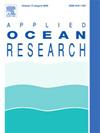A review of pressure loss characteristics during water waves passaging through perforated plates
IF 4.3
2区 工程技术
Q1 ENGINEERING, OCEAN
引用次数: 0
Abstract
When water waves pass through a perforated thin plate (wall), the wave energy will be partially dissipated and the phase of wave motion is also shifted. In the potential flow analysis, an appropriate boundary condition needs to be imposed on the perforated plate to consider the energy dissipation and phase shift. This paper reviews the pressure loss conditions on perforated plates used in the potential flow analysis, i.e., the relationships between the pressure difference on both sides of the plate and the normal fluid velocity across the plate. These conditions include two kinds of linear boundary conditions based on Darcy law and porous medium theory, respectively, and two kinds of quadratic boundary conditions based on the viewpoints of Mei et al. (1974) and Molin (1992), respectively. Several methods for estimating the control parameters (such as porous effect parameter, linearized resistance coefficient, discharge coefficient, and blockage coefficient) in the pressure loss conditions are also reviewed. The internal relations between two linear conditions, between two nonlinear conditions, and between linear and nonlinear conditions are expounded. Then, water wave interaction with a perforated caisson breakwater is considered to show the application of different pressure loss conditions on perforated plates. Finally, the possible research orientation of the pressure loss conditions and their control parameters are prospected.
水波通过穿孔板时的压力损失特性综述
当水波通过穿孔薄板(壁)时,波能将被部分耗散,波浪运动的相位也会发生偏移。在势流分析中,需要对穿孔板施加适当的边界条件,以考虑能量耗散和相位偏移。本文回顾了势流分析中使用的穿孔板压力损失条件,即穿孔板两侧的压力差与穿过穿孔板的法向流体速度之间的关系。这些条件包括分别基于达西定律和多孔介质理论的两种线性边界条件,以及分别基于 Mei 等人(1974 年)和 Molin(1992 年)观点的两种二次边界条件。此外,还综述了估算压力损失条件中控制参数(如多孔效应参数、线性化阻力系数、排流系数和堵塞系数)的几种方法。还阐述了两个线性条件之间、两个非线性条件之间以及线性和非线性条件之间的内部关系。然后,考虑了水波与穿孔沉箱防波堤的相互作用,以说明不同压力损失条件在穿孔板上的应用。最后,探讨了压力损失条件及其控制参数的可能研究方向。
本文章由计算机程序翻译,如有差异,请以英文原文为准。
求助全文
约1分钟内获得全文
求助全文
来源期刊

Applied Ocean Research
地学-工程:大洋
CiteScore
8.70
自引率
7.00%
发文量
316
审稿时长
59 days
期刊介绍:
The aim of Applied Ocean Research is to encourage the submission of papers that advance the state of knowledge in a range of topics relevant to ocean engineering.
 求助内容:
求助内容: 应助结果提醒方式:
应助结果提醒方式:


